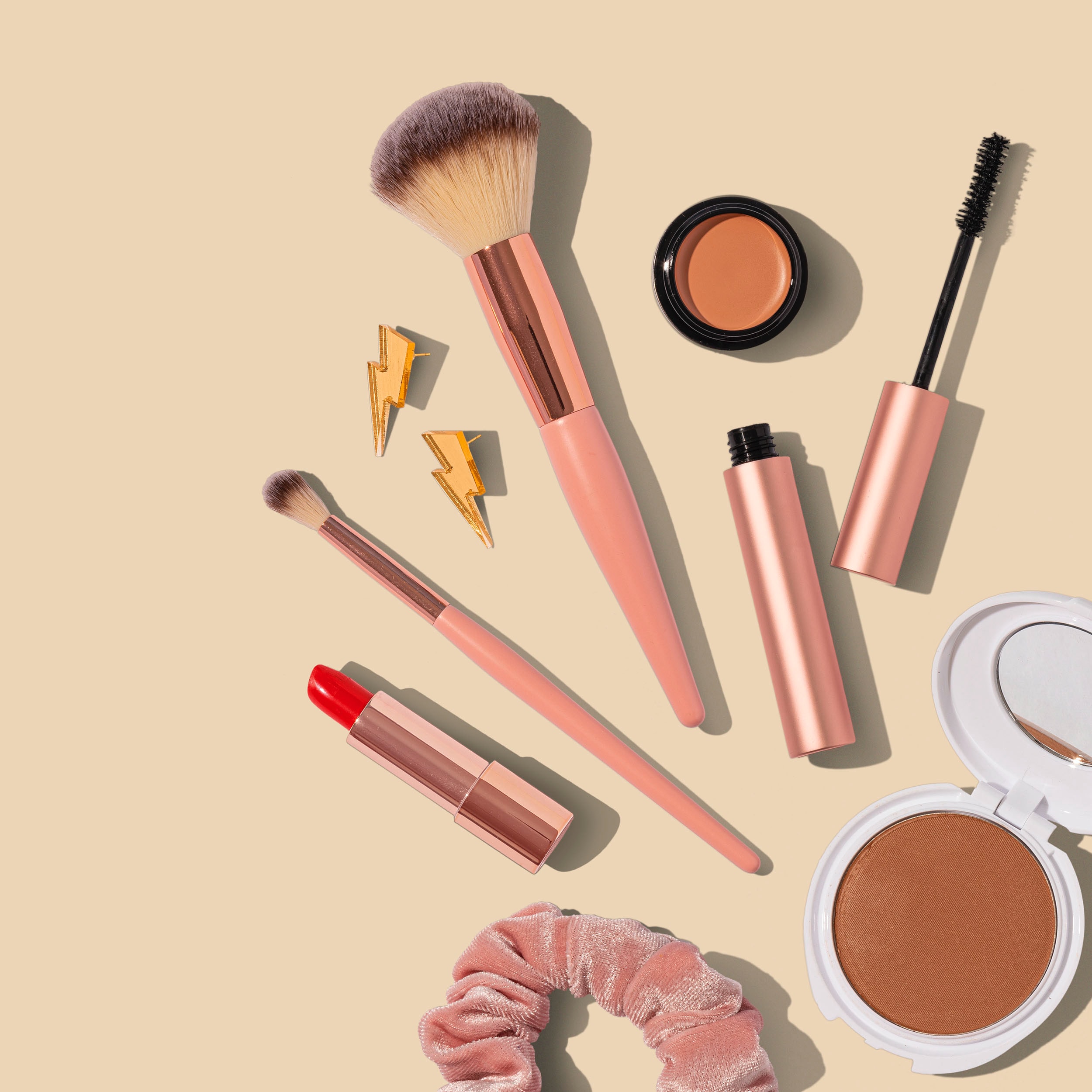A women’s endocrine system is a beautiful network of communication channels, all working in synergy to maintain the biological needs of the female body. This integral system regulates and maintains our hormonal ecosystem and fertile landscape, the barometer to women’s health. However, in our Modern World of synthetics, preservatives, and plasticizers, we’re exposed to toxic chemicals both in our environment and consumer products which directly impacts our appetite, libido, metabolic pathways, sleep, mood, and dysregulates our communication channels. In this article, we’ll be diving into 10 common Environmental toxins that are major known Endocrine Disruptors and provide guidance on how best to avoid them for you and your family.
So how exactly do Endocrine Disruptors (EDCs) affect our hormonal landscape? EDCs can be both manmade or natural but ultimately interrupt the regulation of hormones, stunting the endocrine communication channels, and interfering with the hormonal process.
EDCs can throw off your Endocrine System by:
-mimicking hormones
-blocks hormones
-interferes with hormone production/regulation
-modifies the body’s sensitivity to hormones
Endocrine disruptors can really manipulate one’s endocrine system, changing the production of certain hormones while decreasing the production of others, mirroring hormones themselves, binding to them, or interfering with the hormone signaling process. The disruption of these sensitive biological systems and functions, ultimately leads to reproductive and hormone health disorders.
These endocrine disrupting chemicals are found in our food, water, oceans, cosmetics, soil, and in our air. These toxicants directly affect our endocrine system and we’re seeing major changes in reproductive, hormone, and developmental health. The rise of endocrine disorders and diseases, as well as infertility continue to increase year-by-year.
According to the CDC, “In the United States, among heterosexual women aged 15 to 49 years with no prior births, about 1 in 5 (19%) are unable to get pregnant after one year of trying (infertility). Also, about 1 in 4 (26%) women in this group have difficulty getting pregnant or carrying a pregnancy to term (impaired fecundity).” Endometriosis affects more than 11% of American women between 15 and 44, Polycystic ovary syndrome (PCOS) affects 1 in 10 women of childbearing age, and 10% of women (6.1 million) in the US ages 15-44 have difficulty getting or staying pregnant. (1)

Let’s take a deeper look at some of the top EDCs that are commonly found in our environment and consumer goods:
- BPA (or Bisphenol A) is one of many bisphenol chemicals that are typically added to commercial products as a plasticizer. It’s found in plastic baby bottles, epoxy resins used as the lining for canned goods, tea bags, and most plastic containers. BPA mimics estrogen in the body, an important sex hormone, but when out of balance can lead to estrogen dominance which makes the body susceptible to proliferation of breast cancer cells. BPA has been linked to obesity, heart disease, early puberty onset, hormonal, and metabolic disorders. The major collection of plastic waste has also led to immense contamination of our waters which has impacted the health of our seafood, leaving us susceptible to consuming microplastics daily.
A study published in the journal Environmental Science & Technology has estimated Americans consume more than 70,000 microplastic particles every year from the food we eat and the water we drink. The health impact of ingesting this tiny particles can lead to entering human tissue causing an immune response to the toxicity. (2)
Avoid BPA by eating fresh (non-packaged and processed) foods or buying canned goods from reliable companies (example Native forest uses a vegetable enamel), avoid all single use plastics, ditch plastic water bottles for good, and never heat food or liquids in plastic (BPA will leach out). Remember, BPA-free does not mean it is bisphenol free, there are multiple kind of bisphenol compounds so always inquire about the specifics materials used!
- Dioxins are an environmental pollutant used in our agricultural and industrial economies, that largely impacts our food supply. According to WHO, dioxins are highly toxic and ultimately disrupt the communication between our sex hormones leading to disorders and potential infertility. Dioxins are largely found in factory-produced animal products like meat, milk, eggs, fish, and butter. You can avoid dioxins by consuming pasture raised humanely treated and certified (Certified Humanely raised) animal products that don’t come from toxic processing factory-farmed systems and choose sustainably caught and certified seafood (MSC Blue Fish Label).
- Atrazine is an herbicide that is mainly used on corn crops. Being that corn is one of the largest crops in the country and a main ingredient for most commercial products, it’s also consequently contaminated our water. Evaluation of this chemical has shown detrimental effects on sex hormone production. Researchers have found that this chemical can turn male frogs into females that produce viable eggs. (3) While animal studies don’t directly translate to humans, we have studied how this toxicant interrupts the production and regulation of sex hormones. Corn syrup, for example, and other derivates are shown to block the uptake of copper which is necessary for mitochondrial and thyroid activity.
Avoid Atrazine by purchasing organic produce, ensuring there are no corn derivatives, and filtering your water. Whole corn should always be certified USDA organic and Non-GMO (or non-bioengineered). Be sure to read all product ingredient lists to avoid all potential corn derivatives as well. Here is a quick list of ingredients containing corn derivatives to avoid: Acetic Acid, Baking powder, caramel, dextrose, food starch, fructose, high fructose corn syrup, hydrolyzed protein, malt syrup, maltodextrin, sorbitol, starch, vegetable gum, vegetable protein, vegetable starch).
- Phthalates are a chemical plasticizer used to make plastics softer and more flexible but consequently leach into our food, cosmetics, infant formula, wall coverings, detergents and household cleaners, and our water. This class of chemical toxicants is one of the most widely used plasticizers and has largely been linked to serious health issues in pregnant women, unborn babies, and the development of young children.
According to Dr. Shawna Swan an Environmental epidemiologist states that, “What we’re seeing is that by any measure, male, female, we see a decline at about the same rate. So sperm counts have been declining at about 1 percent per year or even faster. Miscarriage rates have gone up at 1 percent per year. We have increases in women of diminished ovarian reserve. We have increases in men of problems with testosterone leading to the need for testosterone replacement, erectile dysfunction. All of these problems have been getting worse. And, by the way, also testicular cancer going up at about 1 percent per year in Western countries. Genital birth defects in males, also.” (4)
Avoid phthalates by consciously choosing quality skin care and cosmetics, household products, remove processed and fast food from your diet, filter your water, and always read product labels. You can also avoid plastics with numbers 3, 6, and 7 recycling codes whenever possible. Phthalates can also be hidden under the ingredient “fragrance,” which is always best to avoid as parfum or fragrance can contain numerous toxic ingredients.
- Perchlorate is both a natural and manmade chemical compound that’s largely found in rocket fuel, explosives, fireworks, and road flares. According to the EWG it has significantly contaminated much of our produce and milk. The danger in consumption is that it interferes with iodine uptake, an incredibly important mineral nutrient for healthy thyroid function which regulates a large part of our endocrine system. Both your metabolism, brain, and development of children is impacted when there is a thyroid imbalance.
Avoid perchlorate by filtering your water, buying organic produce, strategically incorporating iodine based foods to support the thyroid (example sea salt, sea vegetables) and combat the effects of perchlorate exposure.
- Flame retardants or otherwise known as PBDEs (polybrominated diphenyl ethers), are found in so many of our everyday consumer products from our furniture to our tv, found in plastics and foam. The danger with these chemicals is that they are not bound to the products they’re added to, allowing them to permeate the surrounding area and air.
To avoid flame retardants, opt for furniture made of leather, wool, and organic cotton to avoid these chemicals or purchase from companies that do not use flame retardants and are certified organic.
- Heavy metals unfortunately have infiltrated much of our soil, water, and consumer products, especially in cosmetics and skin care products. Lead, cadmium, arsenic, and mercury are some of the higher levels found in our food, water table, and oceans. Heavy metals disrupt the hormone signaling system that regulate our body’s stress response called the HPA (hypothalamus-pituitary-adrenal) axis. When your body can’t respond to stress, your metabolic pathways will slow causing immune impairment, high blood pressure, mood disorders, hormonal imbalances, mineral deficiencies, and cognitive disorders.
Lead is largely prevalent in paint, building materials, lip stick, and tap water but exists in a multitude of consumer products. Arsenic is also found in our tap water as well as our soil being that many pesticides are high in heavy metals. Rice as a crop in the US for a long time was largely grown in the south and has been studied for having highly toxic levels of arsenic which is thought to be from the pesticides used on the old cotton farms.
Avoid heavy metals by choosing quality cosmetics, paints, organic grains and produce, and always filter your water. To learn about the heavy metals in your local tap water, check out EWG water database: https://www.ewg.org/tapwater
- PFAS and PFOAs (perfluorooctane sulfonate and perfluorooctanoic acid), otherwise known as “Forever chemicals” due to their inability to degrade in the environment, are toxic class of chemicals that build up and wreak havoc in our bodies. They’re used as water, grease, and stain repellents in clothing and furniture, in industrial foam, non-stick cookware, sewage sludge used for fertilizer, it’s found in feed crops such as corn and hay that feed the animals, as well as irrigation water. These chemicals are extremely toxic to our reproductive organs, disrupt the thyroid, and cause immunotoxicity. According to the EWG, “PFAS are detected in the blood of nearly every American,” via exposure from food, water, indoor air, and consumer products. These chemicals can “readily cross the placenta and have been detected in cord blood, indicating direct exposure to a developing fetus, and detected in breast milk.” (5)
To avoid PFAS/PFOAs use cookware that doesn’t have a non-stick coating like cast iron or brands that use a ceramic non-stick coating. Consume grass fed, pasture raised animal products, filter your water, buy organically, and test your soil (if growing your own food) in the case of contamination from neighboring land.
While it’s virtually impossible to completely shield ourselves from environmental toxicants in our Modern-day age, we can make everyday choices and habits that help to reduce our level of exposure and toxic load our body’s carry. Reducing our exposure, helps to improve absorption and utility of micronutrients (minerals, vitamins) which is the foundation that maintains our metabolic health and supports a healthy hormonal ecosystem. When we take the time to educate ourselves of the hazardous chemicals and how best to avoid them by consuming more consciously, we can create a larger space of opportunity for our body to remain in a homeostatic, self-regulating, hormone happy state while also serving our environment and planet in positive ways!
Article Written By:

Resources
- https://www.sciencedaily.com/releases/2019/06/190605100332.htm
- https://www.sciencedaily.com/releases/2019/06/190605100332.htm
- https://link.springer.com/article/10.1007/s002440010300
- https://heavy.com/news/joe-rogan/shanna-swan-phthalates
- https://www.ewg.org/news-insights/news/pfas-and-developmental-and-reproductive-toxicity-ewg-fact-sheet





Leave A Comment
You must be logged in to post a comment.